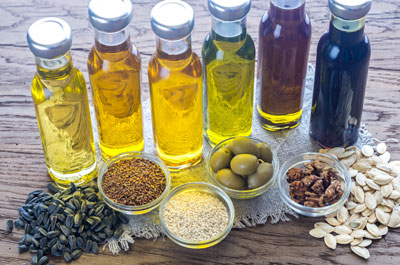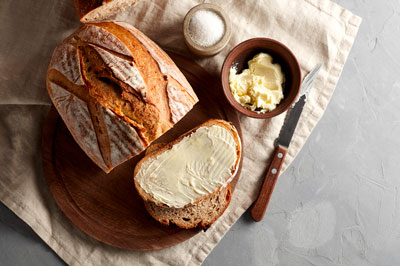First and foremost, and especially before demonising fat in all its forms, it must be reiterated that (good) fat… Is essential to life!
So why can’t we do without fat? Well, because it forms part of the cell walls, plays a part in the process of hormone secretion and supplies energy to the brain, much like the sugar that we need. Again, favour “good sugar” from plants, such as coconut sugar, maple syrup or honey (except for vegans). The sugar is then partly metabolised into glycogen (large sugar molecules that constitute energy reserves) and into fat stored in the adipose tissue.
About one third of your energy intake should come from fat. The stakes are high, which is all the more reason to choose the right fats!
As a great defender of clean, pleasurable, vitamin-packed food, Angèle Ferreux-Maeght, who set up the Guinguette d’Angèle, has designed a “Masterclass” in which she devotes an entire episode to seasonings and therefore… Fats.
An ample opportunity for her to reiterate the importance of fat in cooking:
“Bear in mind that fat allows nutrients to be absorbed properly. For example, beta-carotenes are better assimilated if they are consumed along with fat. Good fat helps nutrients to penetrate the cells (so the brain and nervous system work better!). Fat also plays a part in hormone production, supports the immune system and is an anti-inflammatory agent. And since good fats contain essential fatty acids that the body doesn’t make, you have to get them from elsewhere. Lastly, fat brings texture and strong flavours to any culinary creation”, says the chef and naturopath.
Vegetable or animal fat?
One important feature sets animal fat apart from vegetable fat. The latter, derived from plants, is preferable because it contains more unsaturated essential fatty acids. They help keep the cardiovascular system healthy. As for animal fats, they should be consumed in moderation because they are mainly made up of saturated fatty acids. These fats pose a major health risk because they bring bad cholesterol into the diet and therefore promote cardiovascular and circulatory diseases and overweight.
Bear in mind that there are three types of fatty acids:
- saturated fatty acids (found mainly in red meat)
- polyunsaturated fatty acids (found in oily fish)
- monounsaturated fatty acids (found in vegetable oil).
Ideally, the fat in a meal would be 70% mono- and polyunsaturated fats and only one third saturated fatty acids.
Green light for vegetable fat!

Yes, really! Because these monounsaturated fats (mainly from vegetable oils) cause much less cardiovascular disease. Good vegetable oils include camelina, walnut, coconut, grape seed, pumpkin seed, avocado and olive.
“All of these oils (except olive oil) are sold in small, dark glass bottles and should be kept in the fridge so that they don’t oxidise. Because oxidation, like overheating, modifies the molecules which then become toxic. That’s why we only heat olive oil, coconut oil and clarified butter,” says Angèle once more. “Always favour first cold-pressed virgin oil. And if your oil has gone off, throw it away. But that’s a good sign that it was totally natural!”
Because sure enough, mass producers heat the oils at a high heat, for a long time, so that they keep for as long as possible, even when left out at room temperature. They are also often “enhanced” with chemicals to prevent them from going off. And if they don’t, this is not a good sign. In a nutshell, you should choose your oil very carefully. Go for virgin, first cold-pressed ones, organic if possible.
Most importantly, don’t forget to diversify your oils, sometimes with ready-made (but high-quality) blends, and especially without using palm oil. Rapeseed oil and walnut oil are high in omega 3, while sunflower oil contains mainly omega 6, which should not be consumed to excess, to maintain balance in the intake of good fatty acids.
Red light for animal fat?

Not quite, an amber light would be more appropriate! Cut down on it but don’t cut it out completely, unless you’re vegan. Butter has its merits, as long as you go for the organic variety, or that from local fairtrade supply chains. If you like butter that’s a good thing, because it is a source of vitamins A and D. But eat only about 30 grams a day (about two portions a day, on toast in the morning for example, and a small pat for melting onto fish or mashed vegetables). Not more than that, because it contains mainly saturated fatty acids which increase the risk of developing cardiovascular diseases linked to the inflammatory process generated by bad cholesterol. In addition, there is a tendency to combine meat and cheese, which represents an excessive intake of saturated fatty acids. By gradually replacing animal fats in your everyday diet (switching out butter for a dash of olive oil, for example), you drastically reduce the risk of developing coronary heart disease.
The good fats in the kitchen cupboard!
In practical terms, to balance out your fat intake without making your life difficult, opt for a few basic oils and high-quality butter.
- As for oils: olive for cooking, and take your pick of more olive, hazelnut, walnut, flax, camelina, pumpkin seed or grape seed for use in seasonings.
- Fresh, organic or clarified butter, the latter also being called ghee. This is made from butter heated on a very low heat and filtered, so that only the most fat-rich part is left, stripped of water, lactose and milk proteins. Used in Ayurvedic cooking, it is detoxifying, regenerating and antioxidant. It is considered very nourishing, and also said to bolster the immune and digestive systems. “It’s a very good alternative to butter, because it doesn’t oxidise and keeps for longer!”, says Angèle. However, avoid reduced-fat butter products, which just have added water and margarine and, bar a few exceptions, are higher in salt, added flavouring and colouring agents.
- Steer clear of palm oil, which is too high in saturated fatty acids.
Seasoning ideas
- For tomato and mozzarella salad, opt for olive oil and a pinch of salt. The dressing will take care of itself with the acidity of the tomato, without the need to add vinegar.
- For green salad it’s a matter of taste, but rapeseed oil, either alone or combined with olive or hazelnut oil, strikes a good balance.
- Olive oil drizzled over a whole fish that is still warm from the oven will bring out all of its flavours, without having lost any of its nutrients during the cooking process.
- For meat that’s pan-fried at high heat, its own fat will be enough to give it taste because, again, the fat on the meat takes it to the next level in terms of taste! But melting a pat of fresh butter over the meat at the end of cooking will further enhance its flavour, without going through detrimental changes upon contact with the hot pan.
- Push the boat out with a touch of duck or goose fat from time to time. Lower in saturated fatty acids than butter, it adds flavour like nothing else.
- – Let’s move on to dessert! While butter is a must for pastries, you can replace it with ground cashew nuts, almond paste or even avocado if you like these other flavours, or if you are vegan.
Lastly, with a starter, main course or dessert, go right ahead and put a new twist on your oils. “Combine them with a touch of maple syrup or honey, a little almond or hazelnut purée or a teaspoon of coconut milk to diversify the tastes and textures! For savoury dishes, always add a little flavour with garlic, onion, cardamom and cracked pepper combined with turmeric. Lastly, high-quality oil calls for high-quality vinegar. Genuine PGI balsamic vinegar from Modena, organic cider vinegar for its alkalizing properties and a dash of vitamin C-packed lemon juice. In a nutshell, play around with them all!”, concludes Angèle.







